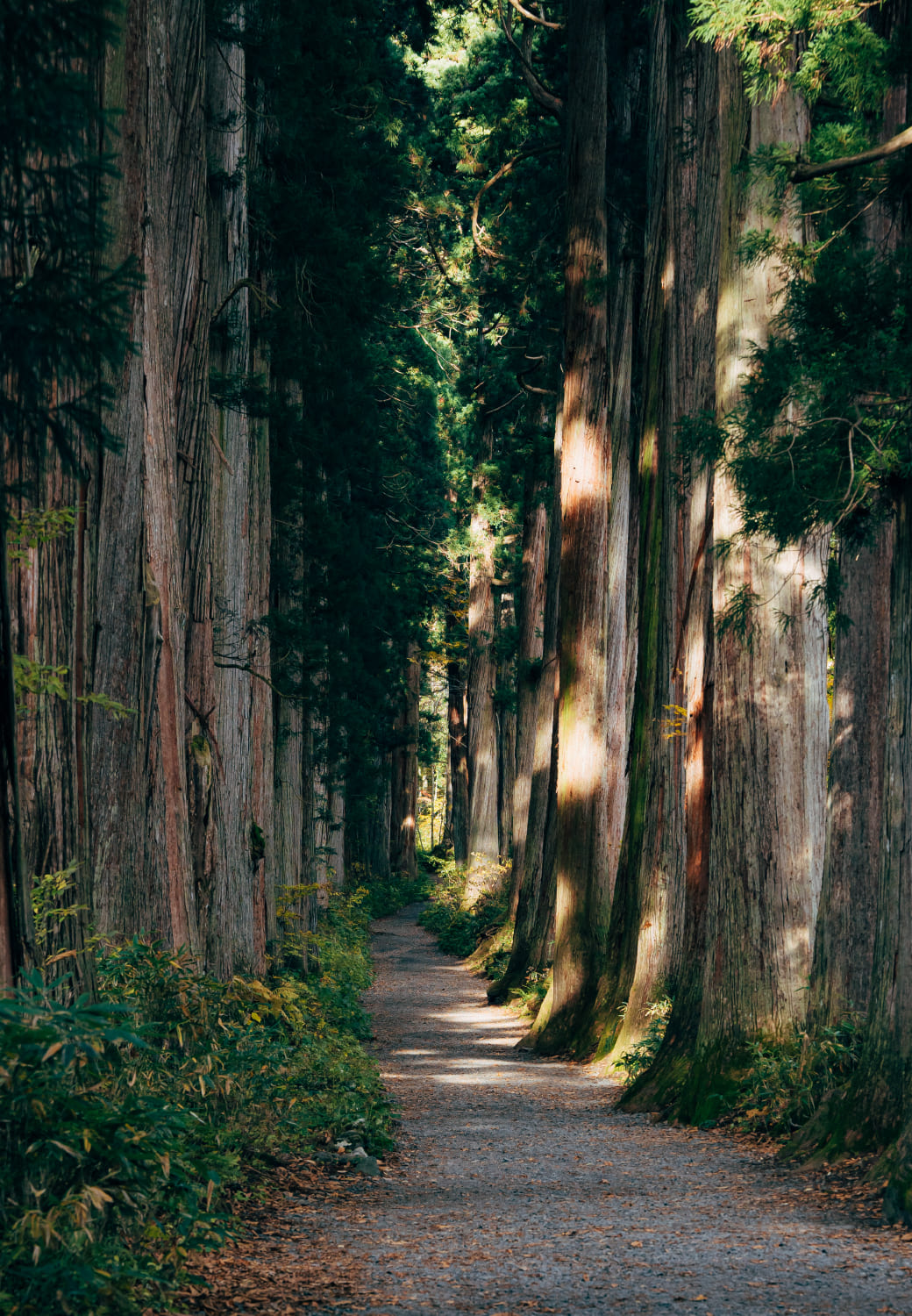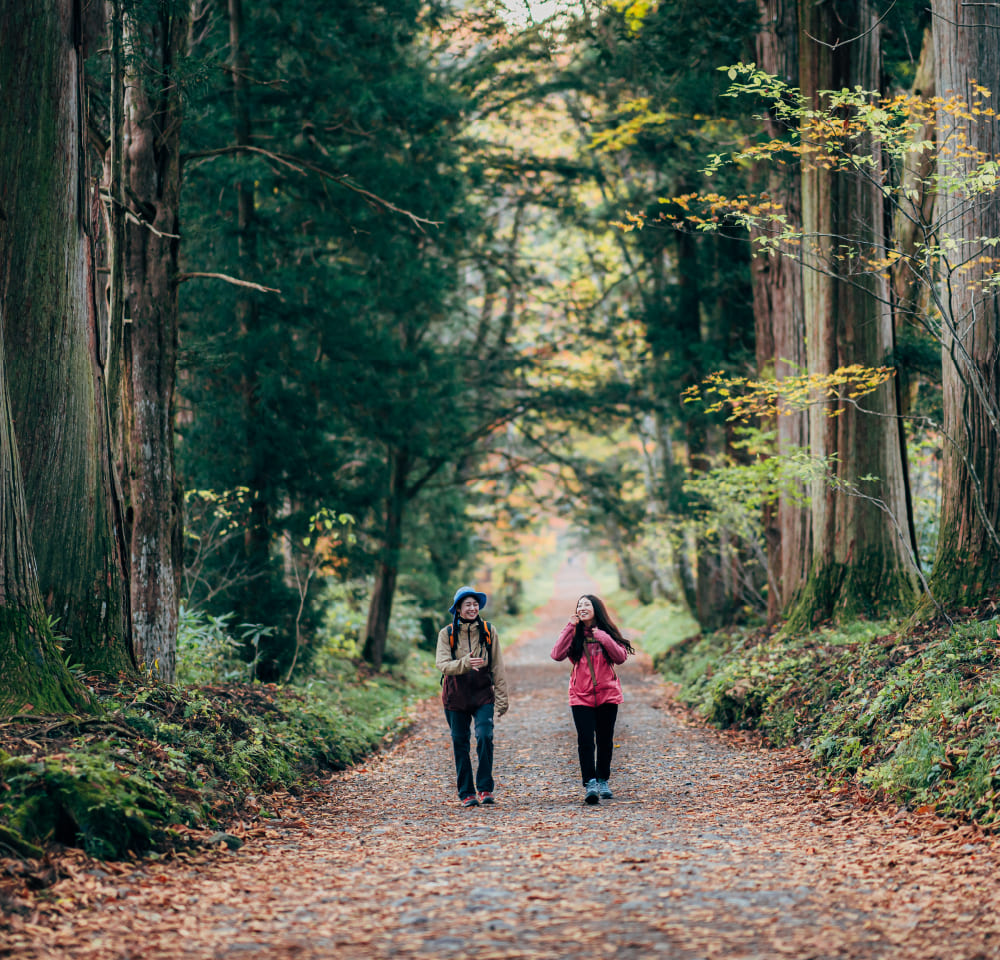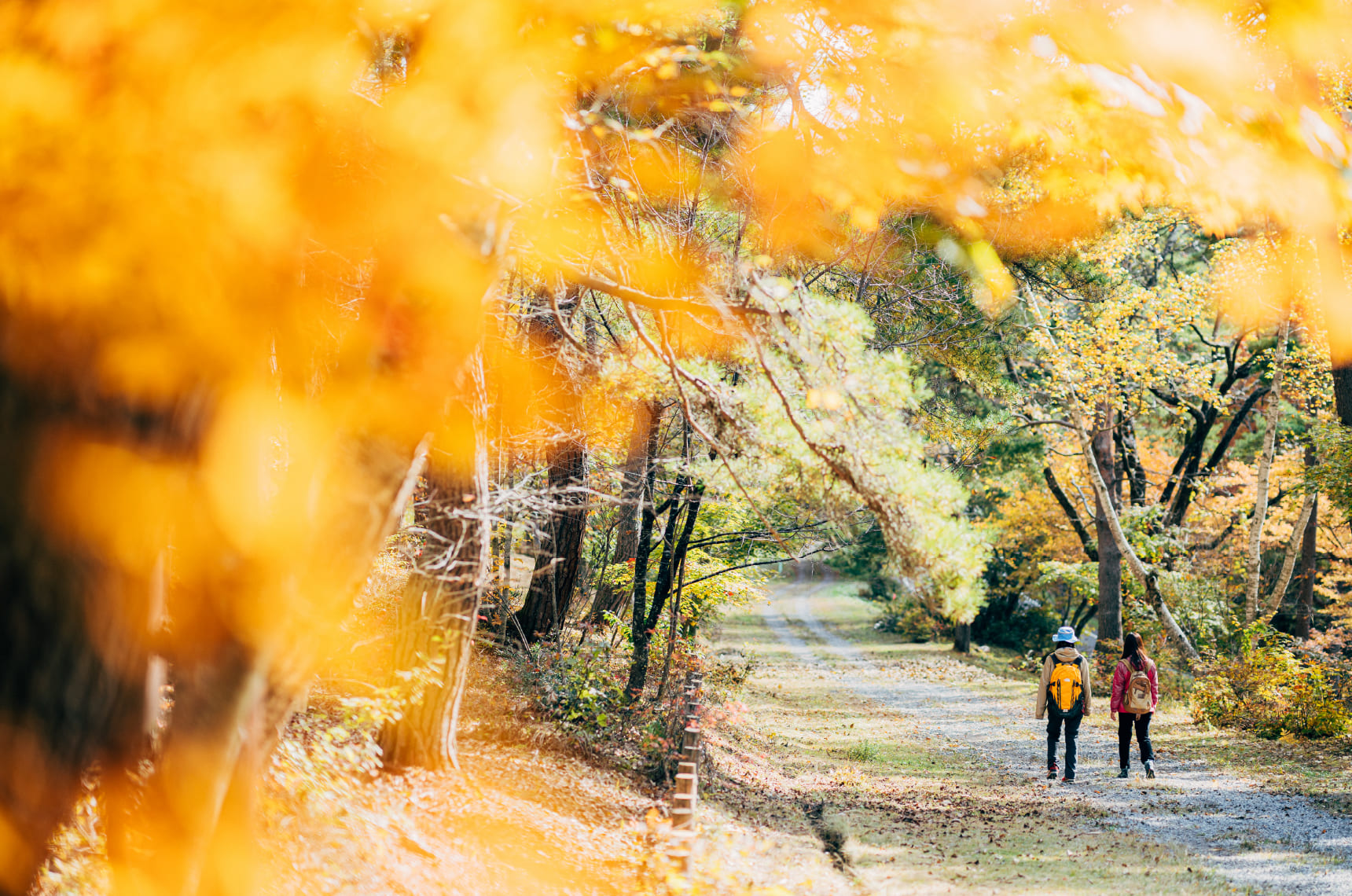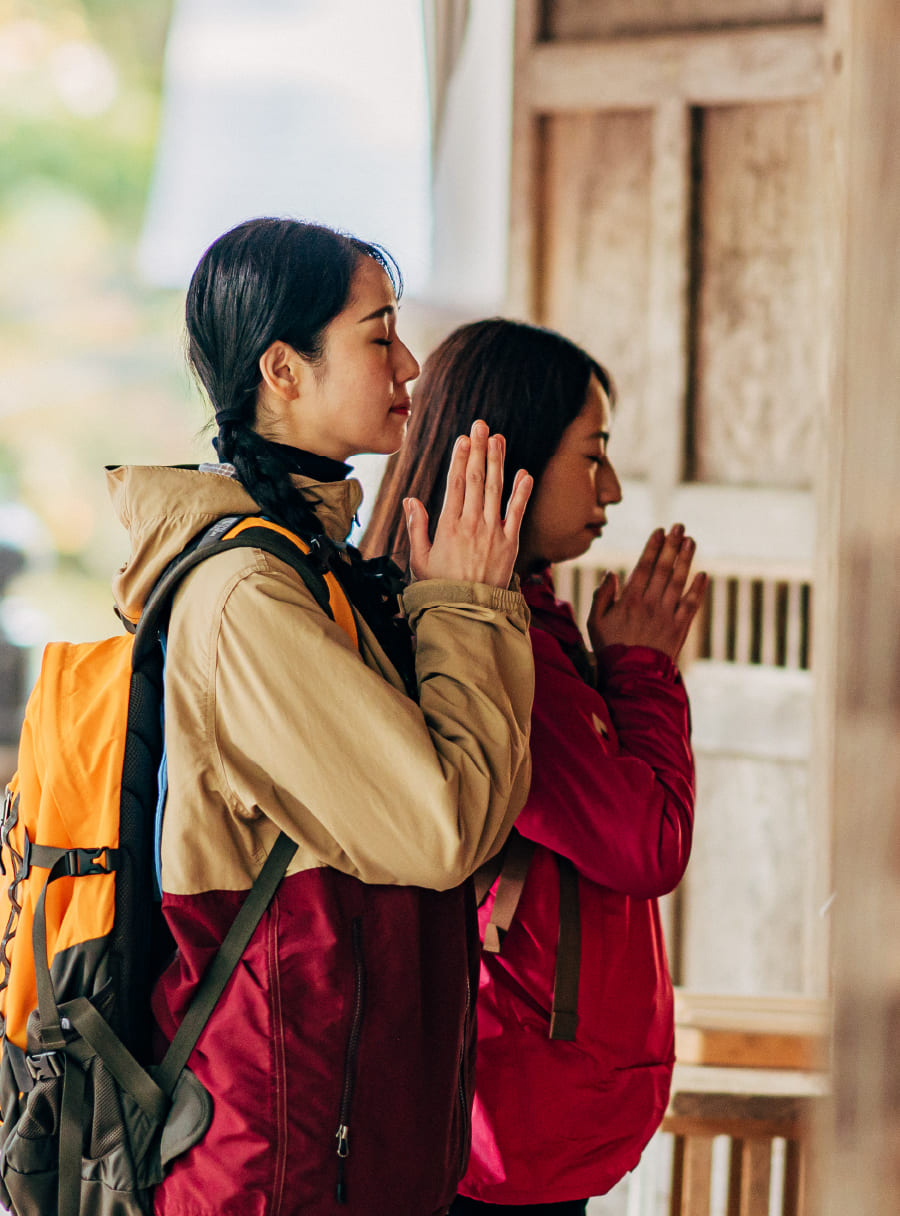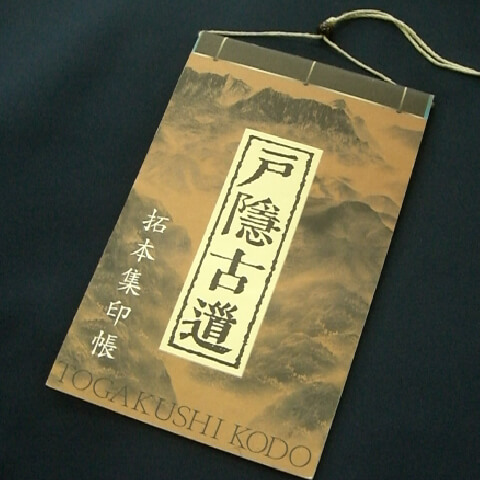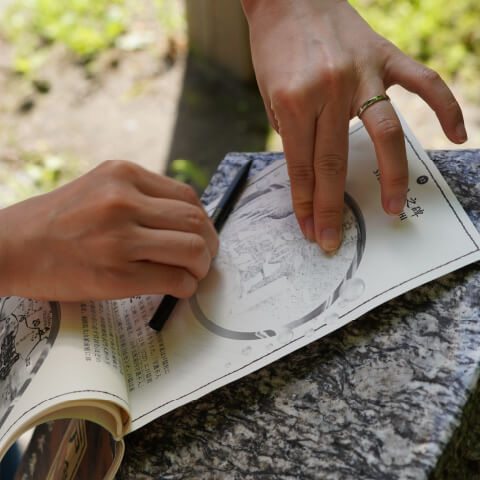ICHINOTORII

The first gate of Togakushi kodo stands on the hill at the foot of Mt.Iizuna. It is a famous sightseeing spot welcoming pilgrims to Okusha Shrine. Today the gate itself is no longer there, as it was destroyed by the “Zenkoji earthquake” in 1847.
HARAIZAWA

This marks the point of separation between the path for Chusha and the path for Okusha. In ancient times, pilgrims used to purify their body and soul in this stream.
YUNOMINEYUHITENBOEN

View point situated just at the intersection between three mountain ranges: the Togakushi range, Arakura range and Hakuba range. The natural scenery is particularly beautiful at sunset.
KUMANONOTO

This statue was erected around the end of the Muromachi period or the beginning of the Edo period, but the meaning or origin of this monument is not clear. Is it assumed that a pilgrim from Togakushi probably built it to commemorate his pilgrimage at Kumano.
JIZOUDO

Located at the entrance of Hokosha district, it is an old building enshrining Buddhist statues of ten judges waiting for us at the last judgement (3 years after death).
HOKOSHA

Built at the end of the Edo period, it is the oldest of the five shrines of Togakushi. The architecture of Hokosha retains traces of the period when Buddhism and Shintoism were mixed.In the main building admire the beautiful wood sculptures. The deity of this shrine is worshipped as a deity of the arts, sewing, easy delivery in birth, family serenity, warding off evil and is believed to be a guardian of women and children.
KANMICHI

In Japanese, Kanmichi means road of the deities. It is a beautiful path through the deep forest of Togakushi. The path connects Hokosha to Chusha and takes about 30 minutes to walk.
FUSHIOGAMISYO

In ancient times, this place offered pilgrims a view to Okusha and they could pray from here. Nowadays, Okusha is not visible because of trees all around.
HINOMIKOSHA

Hinomikosha was built in 1098. Even during the period when Buddhism and Shinto were intertwined, it was exclusively a shrine. Hinomikosha is dedicated to a god of performing arts, good fortune, marriage and fire prevention.
SAIGYOZAKURA

The name of this cherry tree originated from the name of a famous poet, Saigyo, who stopped here during his pilgrimage to Mt. Togakushi.
NOKYOKUYOTO

This monument was originally used by ascetic groups for offerings and prayers. In the early years of the Meiji period, because of the separation between Shinto and Buddhism, this statue was moved a lot of times and finally settled in the main street of Togakushi.
SYUGOFUNYUNOHI

Monument located at the entrance gate of Hisayamakan (former Kenkoji temple inn). During the Edo period, the temple was opposed to the local shogunate and to show his independence this monument was erected.
SANBONSUGI

Located in Chusha Shrine, three magnificent old cedar trees planted between 700 and 900 years ago.
SENCYOSYA

This small shrine is dedicated to people of the Tendai sect killed by some of the Shingon sect during the Warring States Period.
CHUSHA

This shrine was built in 1087. The ceiling painting in the shrine represents a dragon and creates a mysterious atmosphere. Dedicated to the god of wisdom, creativity, success in exams, study and business.
NYONINDOATO

This is the ruin of a gate built to prohibit the access of Okusha to women.
On the left: Path to Okusha On the right: Path to Koshimizu and Nenbutsu pond (Path of Echigo, modern-day Niigata).
ASHIGAMISAN

Literally translated as the shrine of the god of feet. It is related to the myth of Oman; nowadays people come here to pray after injuring their feet.
KOTORIGAIKE

Situated near to Chusha Shrine, the Togakushi range and surrounding forest reflecting on the surface of this pond are beautiful…
SUZURIISHI

Located half way on the path between Kotori pond and Kagami pond. The name of this stone comes from her shape which is quite similar to the shape of a ink stone used for traditional calligraphy. Breathtaking view on the northern Alps from here.
KAGAMIIKE

The most famous waterscape of Togakushi, Kagami ike means mirror lake. Many painters and photographers come here to capture memories of this beautiful reflection.
KOSHIMIZUGAHARA

Koshimizu plateau is a garden for deities and a sacred place for prayers. The Togakushi faith is deeply and inextricably tied to the natural scenery of the surrounding area.
SYAKUCHOMEI KAJOSHO

This is a monument dedicated to Shakuchomei. He was a young ascetic during the Heian period, who exercised esoteric Buddhist practices such as keeping silent and avoiding sleep during 3 years.
CHIGONOTO

This is a small statue built in 1399 to honour the spirit of a child, Chigo, who lied to preserve a good relationship between her mother and father.
NYONIN KEKKAINOHI

A big natural stone erected in 1795 to stop women taking the path to Okusha. They had two choices: return back on the Echigo road passing by the Nenbutsu pond, or continue on to Chusha.
NENBUTUIKE

Shinran Shonin, founder of the Buddhist sect “Jodoshinshu” stopped at this small pond. It is said that while he was praying, spring water suddenly started bubbling out from the bottom of the pond. Nowadays, we can still observe this phenomena.
TOGAKUSHIBOKUJO

At the elevation of 1,200m the pasture of Togakushi is surrounded by three mountains: Mt. Togakushi, Mt.Iizuna and Mt. Kurohime. In this wide field cows and horses graze in the peaceful atmosphere
OKUSHA SANDOGUCHI

Entrance of the pilgrim path to Okusha. You must cross a small river to go forward. The Sakasagawa stream is the borderline between the world of human beings and the world of deities. A stone on the left of the entrance gate states that you have to dismount from your horse to go to Okusha.
OKUSHASANDO SUGINAMIKI

This two kilometre path is lined with more than two hundred ancient cedar trees. Most of them were planted at the beginning of the Edo period and have witnessed more than four hundred years of history. Ruins still remain along the path from ancient times. The magnificent Zuijinmon gate is along the way. The trees exude a spiritual atmosphere allowing us to feel the majesty and power of nature.
KUZURYUSHA

This shrine houses the local god and has the longest history of the five shrines at Togakushi. “Kuzuryu”, a dragon with nine heads, is regarded as the deity of water, the origin of life.
OKUSHA

Okusha shrine is situated deep in the heart of Togakushi. It is the main shrine of worship. The shrine is dedicated to Ameno -tachikarano-mikoto who used his unparalleled power to open the Amano-Iwato cave and retrieve Amaterasu, the sun goddess. The door of the cave fell to Earth, creating the Togakushi mountain range.



